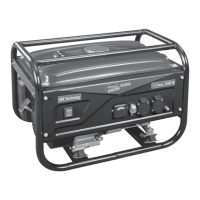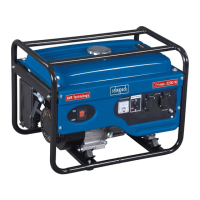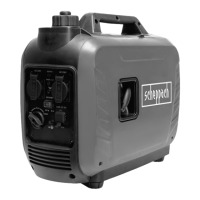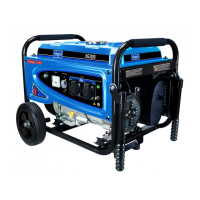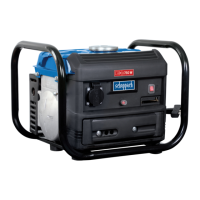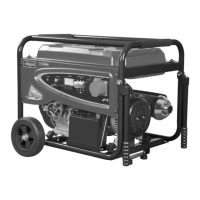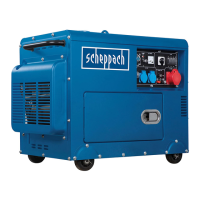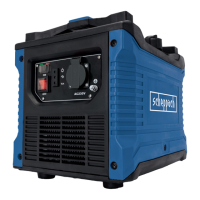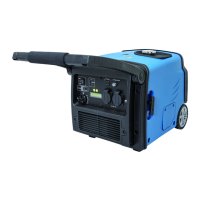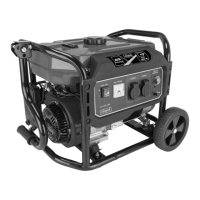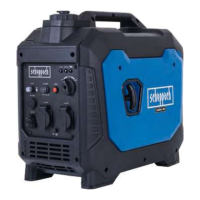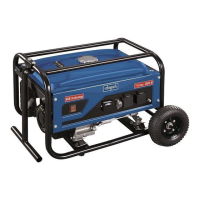www.scheppach.com / service@scheppach.com / +(49)-08223-4002-99 / +(49)-08223-4002-58
26
|
GB
m WARNING
NEVER use gasoline or cleaning solvents with a low
ash point to clean the air lter element. A re or ex-
plosion could result.
Note
Never run the engine without or with a damaged air
lter. Dirt gets so into the engine, causing serious
engine damage can occur. In this case, seller, and
manufacturer disassociate from any warranty.
Check, clean and replace spark plug
Check the spark plug after 10 hours on dirt and grime.
If necessary, clean it with a copper wire brush. Main-
tenance the spark plug after 50 hours of operation
• Open the spark plug cover (Fig. 12 + 13)
• Remove the ignition cable with plug. (Fig. 14 Pos. I)
• Remove any dirt from the base of the spark plug.
• Use a wrench to remove the spark plug (Pos. H).
• Check the spark plug visually. Remove any debris
with a wire brush.
• Look for discoloration on the top of the spark plug.
By default, the color should be bright.
• Check the spark plug gap. An acceptable gap width
is 0.6 to 0.7 mm (Fig. 15)
• Remove the spark plug carefully by hand.
• If the plug has been inserted, tighten them with a
spark plug wrench.
• Attach the spark plug wire with connector on the
spark plug.
NOTE
A loose spark plug can overheat and damage the en-
gine. And overtightening the spark plug can damage
the threads in the cylinder head.
Service information
Please note that the following parts of this product
are subject to normal or natural wear and that the fol-
lowing parts are therefore also required for use as
consumables.
Wear parts*: spark plug
* Not necessarily included in the scope of delivery!
Cleaning
• Keep all safety devices, air vents and the motor
housing free of dirt and dust. Wipe the equipment
with a clean cloth or clean it with compressed air at
low pressure.
• We recommend that you clean your device after
each use.
• Clean the unit regularly with a damp cloth and some
soft soap. Do not use cleaning agents or solvents;
they may damage the plastic parts of the appliance.
Make sure that no water can get inside the unit.
8.7. Electrical safety
Electrical cables and attached devices must be de-
fect free.
Never connect the generator to the mains (power
point).
Keep the cables as short as possible.
8.8 Connecting to earth (g. 2)
The housing can be connected to earth to dischar-
ge static electricity. To do this, connect one end of a
cable to the earthing connection (8) on the generator
and the other end to an external ground (z. B. for ex-
ample to an earthing rod).
8.9 12 V Connection
At the 12 V DC connection (12), a 12 V battery can be
charged using the included cable (18).
9. Maintenance
m WARNING
• Carry out maintenance work only with the stopped
engine.
• Pull the spark plug cap from the spark plug
Oil change
Change the engine oil after 25 operating hours, then
after 50 hours or every three months.
The engine oil change should take place when the
engine is at operating temperature.
• When changing the oil, have a non-leaking con-
tainer available.
• Remove the engine cover (Fig. 6-7 Pos. 5)
• Open the oil ller plug (Fig. 9 Pos. D)
• Drain the old oil into a suitable container by tilting
the generator.
• Fill the engine oil to the upper mark of the dipstick
using the oil-lling container.
• Dispose of the oil in accordance with stipulations.
Take the old oil to a collection point. Most petrol
stations, garages or recycling centres take back old
oil free of charge.
Air lter
The air lter is equipped with two air lter inserts. Fre-
quently cleaning of the air lter prevents carburetor
malfunction.
Clean the air lter and change air lter inserts
• The air lter should be cleaned every 30 hours.
• Remove the engine cover (Fig. 6 - 7 Pos. 5)
• Remove the air lter cover (Fig. 10 Pos. E)
• Remove the lter elements (Fig. 11 Pos. F+G)
• Clean the lter elements with soapy water. After
rinse the lter elements with clear water and allow
to dry thoroughly before retting.
• Reassemble in reverse order
